I know \$V_{CC}\$ is answered here. But not sure about \$NV_{CC}\$ used in, ie., this NXP's i.MX35 Applications Processors for Automotive Products.
I found this video but not sure this is it.
I know \$V_{CC}\$ is answered here. But not sure about \$NV_{CC}\$ used in, ie., this NXP's i.MX35 Applications Processors for Automotive Products.
I found this video but not sure this is it.
TLDR:
In i.MX35 that you have referred to, VCC is supply for processor core and NVCC is supply for I/Os and other peripheral circuitry.
Long Answer:
In case of simple logic gate ICs, we generally need only single supply voltage as entire internal IC circuitry is working on single supply rail may it be 1.8V or 3.3V or 5V. There are cases when IC has internal voltage regulator to generate different power supply rain internally required by some portion of the circuit. In that case also, we need to provide only single power supply only.
But in case of complex SoCs like the one you are referring to, contains very complex circuits which might require different voltages for proper operation. Like, you can run the SoC core at very low voltages like 1.47V max as defined in the i.mx35 datasheet. This low voltage will reduce the switching losses for high speed operation and consequently reduces overall power requirements.
Now for I/Os, you will most likely interface external peripherals which works on LVTTL or CMOS voltage levels. So, to provide ease of interfacing and to eliminate the need for external voltage level translators, it is a facility to connect separate power supply with different and mostly higher voltage compared to processor core to your I/O and internal peripheral sections.
There is one more benefit for providing separate supply, you can also provide some kind of noise filtering between two supply using LC filters. This will provide noise isolation on power rail of processor core from I/O and peripheral power rail.
From page 13:
Supply voltage (I/O) | NVCCmax
From page 14:
The term NVCC in this section refers to the associated supply rail of an input or output.
From page 22:
The term NVCC refers to the power supply voltage that feeds the I/O of the module in question.
So in conclusion, it probably refers to the I/O voltage used by a module.
If you keep reading in that PDF you will find out what \$NV_{CC}\$ is.
I'll copy and paste some information from page 14.
Table 8 provides the recommended operating ranges. The term NVCC in this section refers to the associated supply rail of an input or output
Keep reading at page 14 and look at table 8.
This is probably the worst answer I've ever done here at EE, I'm effectively your ctrl+f.
So \$V_{CC}\$ is the supply rail of your IMX5 and \$NV_{CC}\$ is the supply rail for the individual modules.
The datasheet is quite clear in Table 7

VDD (or QVCC) is for the core , NVCC applies to I/O pins ( for which there are N ? ) different VCC normal ratings specified shown in Table 8 for different I/O types.
The convention was to duplicate the end letters CC or EE for BJT's and DD, SS for CMOS on supply rails for inferred connections and emphasis.
Thus TTL logic and Analog had V+ connected to mainly Collectors \$V_{CC}\$ and Emitters to negative or 0V supply \$V_{EE}\$
When CMOS came out in the early 70's the FET Sources to \$V_{SS}\$ for V+ and Drains to \$V_{DD}\$ for 0V = Gnd.
Depending on whether sub-script fonts were available or avoiding sub-sub scripts, the ending letters might be subscripted and capitalized for emphasis or just lower case like Vdd, Vss or here all upper case.
This chip uses internal level shifters to translate Core to I/O signals and a lower voltage core to consume less power.